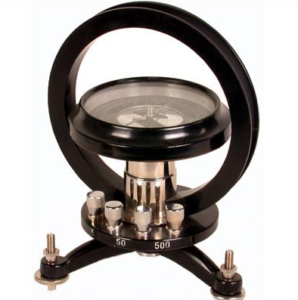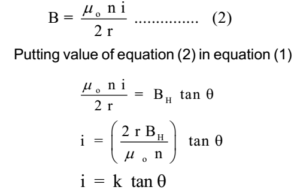Science > Physics > Magnetic Effect of Electric Current > Tangent Galvanometer
In this article, we shall study, the principle, construction, working, sensitivity, and accuracy of the tangent galvanometer.
Principle:
The tangent galvanometer works on the principle of tangent law. The magnetic needle is subjected to two magnetic fields which are perpendicular to each other. One field is due to the horizontal component of the earth’s magnetic field and the other is created by passing the current through the coil of the tangent galvanometer. Under the action of two magnetic fields the needle comes to rest making angle θ with BH, such that B = BH tan θ
Diagram:

Construction:
The tangent galvanometer consists of the following parts.
A coil having a large number of turns:
The coil consists of an insulated copper wire wound on a vertical circular frame. The frame is made up of nonmagnetic material like ebonite.
The frame is fixed vertically on a horizontal base with leveling screws. The coil is provided with two or more coils of a different number of turns. Thus the number of turns can be changed.
A small magnetic needle:
A magnetometer box with a magnetic needle is kept at the centre of the coil in a horizontal plane. The magnetic needle is pivoted at the centre of the coil and can rotate in a horizontal plane.
A light aluminium pointer is pivoted at a right angle to the magnetic needle. When the needle turns through a certain angle the aluminum pointer also turns through the same angle.
The deflection can be read on a circular degree scale. A mirror is placed below the pointer to avoid error due to parallax.
Adjustment:
- All nearby magnets and magnetic materials are removed away from the instrument.
- The instrument is first leveled using spirit level by adjusting leveling screws at the base so that the needle is exactly horizontal and the coil is exactly vertical.
- The coil is then rotated about its vertical axis so that its plane is parallel to the needle. Thus the coil remains in the magnetic meridian.
- The magnetometer box is rotated so that the pointer reads 0° – 0°.
Working:
When the current is not passed through the coil the magnetic needle is acted upon by only a horizontal component of the earth and thus the magnetic needle remains in the north-south direction. When the current is passed through the coil a magnetic field is created by the coil. Thus the magnetic needle is now acted upon by two magnetic fields which are at a right angle to each other. Hence the needle will turn through an angle say θ.
Let BH be the horizontal component of the earth’s magnetic induction and B be the magnetic induction at the centre of the coil due to the current in the coil. The direction of B will be perpendicular to the plane of the coil and hence perpendicular to BH. By the tangent law
B = BH tan θ …………. (1)
The magnetic induction at the centre of the coil due to current in the coil is given by

Where k is a constant, called the reduction factor of the tangent galvanometer.
∴ i ∝ tan θ
Thus in a tangent galvanometer, the current through the coil is directly proportional to the tangent of the angle of deflection of the needle. Due to this characteristic of the galvanometer is known as the tangent galvanometer. Knowing k and θ we can calculate the value of the current through the coil.
The Sensitivity of a Tangent Galvanometer:
The sensitivity of the tangent galvanometer is defined as the ratio of the change in deflection of the galvanometer to the current producing this deflection.
Sensitivity = dθ / di
A galvanometer is said to be sensitive if it gives larger deflection for a small current.

Thus the sensitivity of tangent galvanometer can be increased by
- Increasing the number turns (n) of the coil,
- Keeping the value of cos²θ small, i.e. deflection should be small,
- Decreasing the magnetic induction (BH). It can be done by putting auxiliary bar magnet below the magnetic needle such that it opposes the magnetic induction BH
- Decreasing the radius (r) of the coil.
Limitations in Increasing Sensitivity:
- If the number of turns of the coil is increased the radius of the coil will not be the same for all turns and the magnetic induction at the centre is not uniform.
- The increase in the number of turns increases the resistance of the coil of the galvanometer.
- If the radius of the coil is made small the magnetic field at the centre will be non-uniform.
- If θ is kept small accuracy decreases. Accuracy is maximum when θ = 45°
Accuracy of Tangent Galvanometer:
Let dθ be the small error in measuring the deflection θ so that the corresponding error in the current calculated is di when measuring a current ‘i’. Then

Now it is clear that the accuracy is maximum when the error is minimum i.e. the quantity di/i is minimum. i.e. the quantity (sin 2θ) is maximum. i.e.
sin 2θ = 1
∴ 2θ = sin-1(1)
∴ 2θ = 90°
∴ θ = 45°
Thus the accuracy of a T.G. is maximum at a deflection of 45°.
The accuracy can be increased by
- Using light and long pointer.
- Increasing the radius of each turn in the coil. Larger is the radius greater will be the accuracy. Because due to the larger radius the magnetic induction produced near the centre of the needle will be more and nearly uniform.
- Decreasing the number of turns in the coil. For greater accuracy, the number of turns in the coil must be lesser. Because if the number of turns is large there can be the difference in the radii of different turns and hence current cannot be calculated accurately.
Note:
If we study the conditions of accuracy and sensitivity, we can note that they are contradictory to each other thus accuracy and sensitivity cannot be combined in a single instrument.
Distinguishing Between MCG and a TG:
| Moving Coil Galvanometer | Tangent Galvanometer: |
| Magnet is fixed and the coil is free to rotate | The coil is fixed and the magnet is free to rotate. |
| Current is directly proportional to the angle of deflection | Current is directly proportional to the tangent of the angle of deflection |
| Initial adjustment of the instrument with respect to the magnetic meridian is not necessary. | Initially, the coil must be set in the magnetic meridian. |
| Stray magnetic fields do not affect the reading. | Stray magnetic fields affect the reading. |
| It has a linear scale | It has a non-linear scale |
| It is more sensitive | It is less sensitive |
| Sensitivity can be increased without affecting the accuracy | As the tangent galvanometer is more sensitive its accuracy decreases. |
Previous Topic: Ammeters and Voltmeters
Next Topic: Particle Accelerator (Cyclotron)